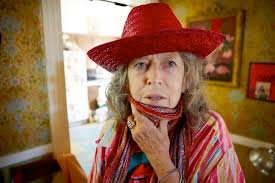Linda Montano: Making Friends with the Inevitable
A performance art piece of oh, say, an hour’s duration? No problem.
How about a piece three or even four hours long? OK, maybe if you include a break or two. But how about a performance piece that lasts a full year? Or, for that matter, 14 years? Or, for goodness sake, a performance piece that lasts an entire lifetime? Now you’re in the rarefied territory staked out by Linda Montano.
Montano, a native daughter of Saugerties, has an international reputation as an artist whose protean and provocative body of performance work has consistently taken risks that many another artist would shy away from. Inspired as much, if not more, by Catholic, Hindu, and Buddhist religious disciplines as by her performative contemporaries (she spent two years in a convent as a young woman, had a three-year sojourn in a Zen monastery, and since the 1970s has studied at the late Doctor Mishra’s Ananda Ashram), the chief thrust of her half-century of work has been to question, blur, and transcend the boundaries between life and art. In the process, she has relentlessly honed her attention, cultivated great stamina, and created work that has been inclusive and communal, connecting people all over the globe.
“I just did a three-hour LAUGH-CRY ENDURANCE via Zoom in Chile,” she said in a recent email, responding to a question about what kind of work could speak to the toll that Covid has exacted on live performance. “I’m fine with repeating that online again and again, or having 9,577 of us lying on the floor, laughing and crying for seven hours! Hugging after?”
Over the course of her career Montano has produced over 60 videos (thanks to Tobe Carey and Jim Barbaro), nearly all of them free on YouTube; she has written several books, created and embodied an amazing array of personas, and performed works as varied as becoming a bell ringer for the Salvation Army and collaboratively enduring a seven-year exploration of the seven chakras, the energy centers of the body.
“My work is varied because I follow the call,” she says. “The push to create disregards the art rule, which is to focus on one way. I’m an art slut, a rule-breaking jester. I do what I need to do, not what the art business wants.”
One of the things she has needed to do from the outset — from her early fascination with the Sorrowful Mysteries of the Rosary, especially the crucifixion of Jesus — has been to confront the reality of death without flinching. As early as 1964, she sculpted a crucifix out of found objects in her family’s backyard; the form of the crucifix, its vertical and horizontal axes, has lent itself to much of her work since—for example, her deeply moving video “Mitchell’s Death” (1978), in which she commemorated the sudden death of her husband, Mitchell Payne, by chanting, in one note, the story of her response to hearing the news. As she writes in her book Art in Everyday Life(1981), “The evolution from the crucifix as a real-time occurrence to using the sign as an abstract organizing device has been gradual and in retrospect, correct.”
There is nothing maudlin or morose about Montano’s ongoing dance with death; she is singular in her ability to plumb profound sorrow without losing her sense of humor. But she remains, if you will pardon the phrase, dead serious about her work.
“My venture into long endurances were strategies that allowed me to let go of time/space and resulted in a death-like quiet,” she says. “It’s good to practice and become friends with the inevitable and my art has allowed me that gift.”
By Mikhail Horowitz


